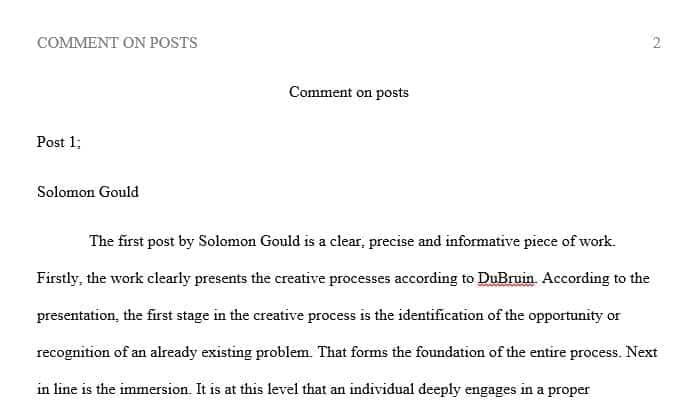Thinking about the five steps in the creative process, identify how your chosen leader exemplified
Thinking about the five steps in the creative process, identify how your chosen leader exemplified some or all of these steps in the creative process as elements of personal, political, and positional power to effect change in organizational culture. Please see attached rubric for criteria, original work only as the database checks for plagiarism. After initial discussion post, I will also need a response to two additional student postings, I will provide that to the tutor once the initial post is given. Student response post criteria: In your response posts to classmates, discuss how your chosen leader’s skills in using the creative process differ from the skills of your peers’ chosen leaders.
Student:
Thank you. As per the original question, I will provide you two student posts as soon as they are available as the discussion requires two responses to other students as well.
Student response post criteria: In your response posts to classmates, discuss how your chosen leader’s skills in using the creative process differ from the skills of your peers’ chosen leaders.
1st Student Post:
Solomon Gould
Creativity
COLLAPSE
Step 4, or insight, occurs when the problem-conquering solution flashes into the person’s mind at an unexpected time, such as on the verge of sleep, during a shower, or while running. This step is also known as the ‘Aha’ moment. Howard Schultz identified that the U.S. was without such a chain. He proposed his concepts to the existing owners of Starbucks and received resistance instantaneously. It was at this moment that Schultz had his ‘Aha’ moment and knew it was his time to leave Starbucks.
Step 5, or verification and application, is when the individual sets out to prove that the creative solution has merit. Verification procedures include gathering supporting evidence, using logical persuasion, and experimenting with new ideas. Application requires tenacity because most novel ideas are first rejected as being impractical. Schultz left Starbucks and started up his own brand, which he called ‘Il Giornale’ after the Milan newspaper. Over the next two years, Shultz fine-tuned his new brand and had such success that he purchased the Starbucks chain from the original owners and the rest is history.
Each step of the way, Schultz capitalized on the creativity process using his personal, political and positional power. Today, Schultz and his executive leadership prioritize creativity as one of the top most emphasized goal tasks amongst the employees. New ideas and inights are invitedly brought forth by employees of all statures.
DuBruin, A. (2016). Leadership: Research Findings, Practice, and Skills, 8th Edition.
—————————————————————
2nd Student Post:
Daniel Bruce
Creativity Process – Zuckerberg
COLLAPSE
References:
Leonard, Heather. (2013, March 13). The day Facebook turned down $1Billion. Retrieved from (http://www.businessinsider.com/the-day-facebook-turned-down-1-billion-2013-3
DuBrin, Andrew. (2015, January 1) Leadership: Research findings, practice and skill. Cenage. 8th edition. Chapter 11, section 11-1.
As discussed earlier I need a short response to both student postings, it doesn’t have to be more than 200 words for each response.
Answer preview to thinking about the five steps in the creative process, identify how your chosen leader exemplified



